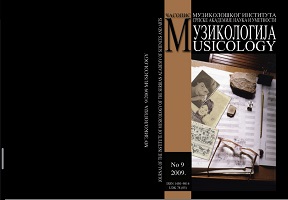O (не)завршености Шенберговог ораторијума Die Jakobsleiter
On (In)Completeness of Schoenberg’s Oratorio Die Jakobsleiter
Author(s): Dragana Jeremić Molnar, Aleksandar MolnarSubject(s): Cultural history, Music, Sociology of Art, Sociology of Religion, History of Art
Published by: Muzikološki institut SANU
Keywords: Arnold Schoenberg; Die Jakobsleiter; romanticism; "free" atonality; sublime; theosophy; Judaism;
Summary/Abstract: The question why Arnold Schoenberg did not complete his oratorio Die Jakobsleiter according to his initial plan, but instead decided to set to music only the text from the first part of the work and to compose the Great symphonic interlude, is still unanswered today and is quite worthy of continuing scholarly attention. In this article the authors argue that Schoenberg’s religious beliefs played a central role in both creating and (re)shaping Die Jakobsleiter. In other words, Schoenberg’s post-war decision to abandon the plan to compose music for the second part of the oratorio (i.e. for the rest of the libretto published in 1917), was a direct outcome of the transition of his Weltanschauung from unorthodox theosophy and open-minded cosmopolitism towards more earthly oriented and nationally uncompromising Judaism. According to these new beliefs, Schoenberg conceived the Great symphonic interlude as a real denial of all human endeavors to reach transcendence and as an epitaph for the romantic “infinite urge”, which so passionately inspired composers from the previous epoch. By doing this Schoenberg abandoned the tradition of musical romanticism, as well as his own “free” atonal project, which was counterpart to his former beliefs and which, in different conditions, was found to be “heretical” according to the newly revealed Law of Dodecaphony.
Journal: Muzikologija
- Issue Year: 1/2009
- Issue No: 9
- Page Range: 113-131
- Page Count: 19
- Language: Serbian

